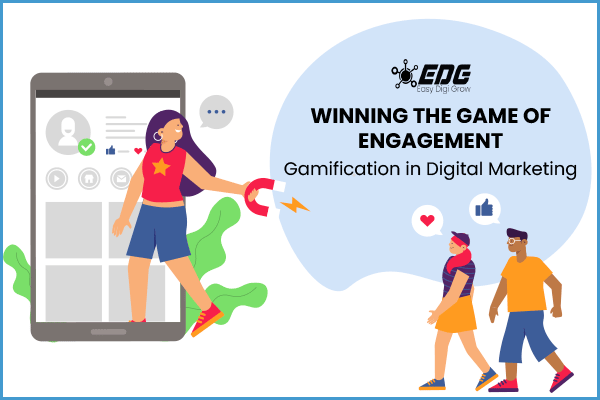Are you tired of the same old digital marketing strategies that fail to captivate your audience? Look no further than gamification in digital marketing!
Imagine turning your marketing campaigns into thrilling adventures, where your customers are actively participating, competing, and winning exciting rewards.
Gamification is the secret sauce that can supercharge your engagement levels and transform your brand into a captivating force.
In this blog, we will captivate the world of gamification, revealing how it can revolutionize your digital marketing strategies, ignite a sense of excitement among your target audience, and propel your brand to new heights.
So, buckle up and get ready to embark on an exhilarating journey into the world of gamification in digital marketing.
Understanding Gamification in Digital Marketing
What is Gamification?
Gamification is the practice of applying game mechanics and principles to non-game contexts, such as marketing.
It utilizes elements such as points, badges, leaderboards, challenges, and rewards to inspire and captivate users, driving their motivation and active participation.
Why Use Gamification in Digital Marketing?
Gamification provides a unique and interactive way to connect with customers. By making the marketing experience enjoyable and rewarding, businesses can increase user engagement, build brand awareness, foster customer loyalty, and collect valuable data.
What’s Trending on EasyDigiGrow: guide to boost your SEO ranking.
Strategies for Implementing Gamification in Digital Marketing
- Setting Clear Objectives
Before implementing gamification, businesses must define clear objectives for their campaigns. Whether it’s increasing brand awareness, driving website traffic, or boosting sales, setting measurable goals helps align the gamification strategy with overall business objectives.
- Knowing Your Target Audience
Understanding the demographics, preferences, and motivations of your target audience is crucial for effective gamification. By tailoring the game mechanics, challenges, and rewards to the specific needs and interests of your audience, you can create a more engaging and personalized experience.
- Designing Meaningful Rewards
Rewards play a crucial role in gamification. They should be relevant, desirable, and meaningful to the target audience. Whether it’s virtual badges, exclusive discounts, or access to exclusive content, rewards should provide value and motivate users to continue engaging with the brand.
- Incorporating Game Elements
To create an immersive gamified experience, businesses should incorporate various game elements such as points, levels, leaderboards, challenges, and social interaction. These elements enhance the overall engagement and motivation of users, making the experience more enjoyable and memorable.
4 Benefits of Gamification in Digital Marketing
- Increased User Engagement
Gamification captures users’ attention and encourages them to actively participate in digital marketing campaigns. By making the experience enjoyable and interactive, businesses can keep users engaged for longer periods, leading to increased brand exposure and conversions.
- Enhanced Brand Awareness
Gamification offers an opportunity to create memorable experiences for users. Through engaging gameplay and well-crafted narratives, businesses can leave a lasting impression on their target audience, leading to increased brand recognition and recall.
- Improved Customer Loyalty
By incorporating rewards, challenges, and progression systems, gamification creates a sense of achievement and motivation for users. This fosters a deeper connection between the customer and the brand, increasing customer loyalty and advocacy.
- Data Collection and Analytics
Gamified experiences provide valuable data insights. By tracking user behavior, preferences, and performance within the game, businesses can gain valuable insights into their target audience. This data can be used to refine marketing strategies, personalize experiences, and improve overall performance.
Check out our detailed guide to understand the impact of digital marketing on your business.
Best Practices for Successful Gamification Campaigns
- Creating a Compelling Narrative
A well-crafted narrative adds depth and context to the gamified experience. By integrating storytelling elements, businesses can create an emotional connection with the users, making the overall experience more immersive and memorable.
- Providing Real-Time Feedback
Real-time feedback is essential in gamification as it keeps users informed about their progress and performance. Instant feedback, such as progress bars, notifications, and achievements, enhances user engagement and motivates them to continue participating in the game.
- Fostering Social Interaction
Incorporating social features, such as leaderboards, challenges, and multiplayer modes, encourages users to compete and collaborate with others. Social interaction enhances the sense of community and creates opportunities for user-generated content and virality.
- Offering Challenges and Progression
Gamification should provide a sense of challenge and progression to keep users engaged. By offering increasingly difficult challenges, unlocking new levels, or introducing surprises and hidden content, businesses can maintain users’ interest and motivation throughout the gamification campaign.
Overcoming Challenges in Gamification
- Balancing Fun and Business Goals
While gamification aims to provide an enjoyable experience, it should align with business objectives. Finding the right balance between fun and achieving marketing goals is crucial to ensure that the gamified experience serves its purpose effectively.
- Avoiding Excessive Complexity
Gamification should be accessible and easy to understand. Overcomplicating the game mechanics or introducing unnecessary complexity can deter users and hinder their engagement. Simplicity and clarity are key to a successful gamification campaign.
- Ensuring Accessibility and Inclusivity
When implementing gamification, businesses should consider the accessibility needs of all users. This includes providing alternative input methods, accommodating various devices and screen sizes, and ensuring the game is inclusive and enjoyable for users with disabilities.
Examples of Gamification in Digital Marketing in India
- PhonePe’s Scratch Card:
PhonePe’s Scratch Card is a gamified marketing campaign that offers users the chance to win prizes by simply scratching a card. The cards are available on the PhonePe app and can be scratched once a day. If users scratch a winning card, they can win prizes such as cashback, discounts, and vouchers. This campaign has been very successful in driving engagement and downloads for PhonePe.
- Myntra Fashion League

Myntra’s Fashion League is a gamified marketing campaign that offers users the chance to win prizes by shopping on the Myntra website or app. The more users shop, the more points they earn. The user with the most points at the end of the campaign wins the grand prize. This campaign was launched in 2022 and has been very successful in driving engagement and sales for Myntra.
Also, check out: SEO vs. PPC – Which strategy you should choose
The Future of Gamification in Digital Marketing
- Emerging Technologies and Trends
As technology advances, new opportunities for gamification in digital marketing are emerging. Augmented reality (AR), virtual reality (VR), and mixed reality (MR) are poised to revolutionize gamified experiences, creating even more immersive and interactive campaigns.
- Personalization and Customization
The future of gamification lies in personalized experiences. By leveraging user data and advanced algorithms, businesses can create tailored gamified journeys that cater to individual preferences and behaviors, maximizing engagement and impact.
- Gamification in Different Industries
While gamification has found success in various industries, including fitness, e-commerce, and education, its potential extends to many other sectors. From healthcare and finance to employee training and customer support, gamification can revolutionize how businesses interact with their audiences.
Conclusion
Gamification in digital marketing is a powerful strategy that can breathe new life into your marketing campaigns. By leveraging game mechanics, challenges, rewards, and interactive elements, businesses can create immersive experiences that captivate their audience and drive meaningful engagement.
At EasyDigiGrow, we understand the potential of gamification in revolutionizing digital marketing strategies. Our digital marketing company in Delhi NCR specializes in helping businesses leverage the power of gamification to create unforgettable experiences for their customers.
So, if you’re ready to take your digital marketing to the next level and unlock the full potential of gamification, contact EasyDigiGrow for digital marketing services today.
Together, we can transform your brand into a captivating force in the digital realm.
FREQUENTLY ASKED QUESTIONS
- How does gamification benefit digital marketing efforts?
Gamification benefits digital marketing efforts by increasing user engagement, improving brand awareness, fostering customer loyalty, and providing valuable data insights for marketing strategies.
- What are some popular game elements used in gamification?
Popular game elements used in gamification include points, badges, leaderboards, challenges, levels, rewards, and social interaction features.
- Can gamification be applied to different industries?
Yes, gamification can be applied to various industries, including fitness, e-commerce, education, healthcare, finance, and more. The key is to tailor the gamified experiences to the specific needs and preferences of the target audience.
- Are there any specific gamification platforms or tools recommended for small businesses in Delhi/NCR?
There are various gamification platforms and tools available, such as Bunchball, Badgeville, and Gamify, which can be customized and integrated into small businesses’ digital marketing strategies.
- Can gamification be used to collect data and insights for small businesses?
Yes, gamification can provide valuable data and insights about user behavior, preferences, and performance, which can be used to optimize marketing strategies, personalize experiences, and enhance customer understanding.
- How can small businesses in Delhi/NCR measure the effectiveness of their gamification campaigns?
Key metrics to measure effectiveness include user engagement, conversion rates, customer retention, social shares, and feedback or reviews from participants.
 seolounge
seolounge



